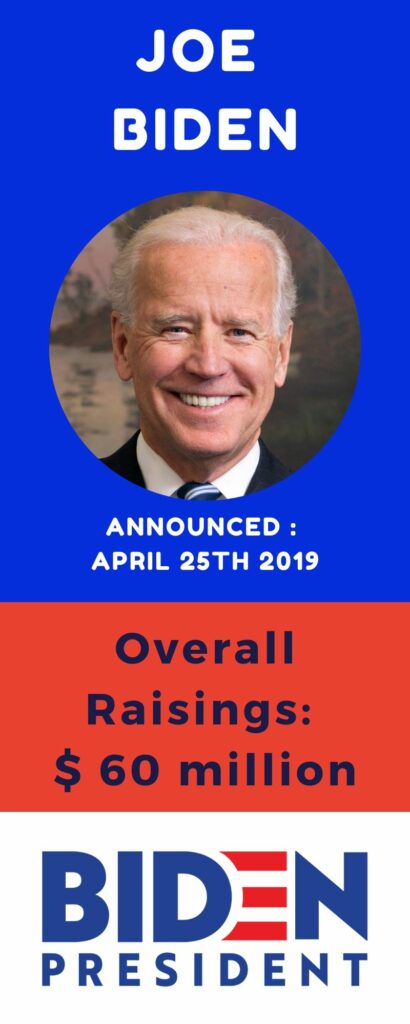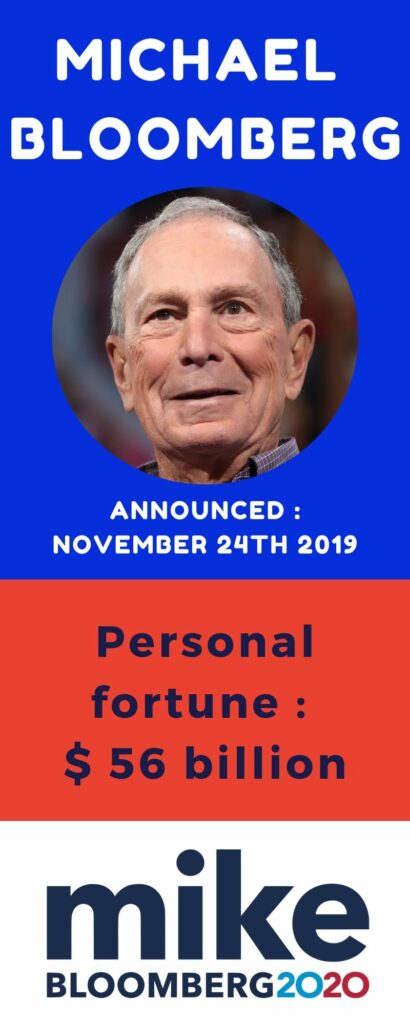The 2020 Democratic Presidential Primary is heading to Iowa on February 3rd where the 14 remaining candidates will face each other during the first caucus of the campaign. Candidates have already spent an all-time high $1.5 billion. Here’s a breakdown of four of the candidates’ campaign finances.
The established candidate
Joe Biden’s resume is as long as his popularity is strong in the Democratic Party. He was Barack Obama’s Vice-President for both terms (2009-2017). He has been a member of the Democratic Party for 50 years, and has had a huge influence within it.
This is a big asset when you want to run for presidency. He was one of the last to announce his bid for the 2020 Democratic presidential Primary. But raising money has not been an issue for him.
He announced his candidacy on April 25th, 2019. He raised almost $22 million in the first quarter of his campaign.

“Raising major money is a crucial part of the presidential race: Campaign finance is a barometer for grassroots enthusiasm as well as fuel for the nuts and bolts of the primary, from running ads to hiring staff in early primary and caucus states,” said Beatrice Jin, political journalist for Politico.
In eight months, Joe Biden raised more than $60 million, the fourth highest amount among candidates behind Bernie Sanders ($86.1 M), Pete Buttigieg ($76.1 M) and Elizabeth Warren ($71 M).
But Biden’s campaign funds don’t come from the die-hard supporters. On September 30th, 2019, a majority of his funding came from large contributions (64.89% from itemized individual contributions meaning people who gave more than $200) according to data from the Federal Elections Commission. And only 35% of donations came from small individual contributions (< $200). But at the end of the third quarter his cash reserves were low (only $9 million).
For Yelena Dzhanova, a CNBC journalist, this lack of cash reserves is dangerous for his campaign. “Biden’s dwindling fundraising and cash reserves have his donors and fundraisers worried he might not have the resources to make it beyond the Super Tuesday primaries March 3”.
« His standing atop the national polls hides that he can be short on cash »
The worst-case scenario was swept away with the announcement of the 4th quarter figures. Biden’s campaign has raised almost $23 million over the last three months.
“Biden demonstrated he could stop the bleeding as his new online fundraising stats suggest he has room to grow, despite worries that he had maxed out from the kinds of donors who would support him,” said Marc Caputo, journalist for Politico.
On the other hand, his standing atop the national polls hides the fact that he can be short on cash. In quarters 2 and 3, Joe Biden spent almost $28.8 million. He spent nearly $3.5 million in digital advertising alone during the third quarter.
In fact, ten years after his last solo campaign, he needs to build up a new donor list. This is also the reason why he spent so much money on travelling. For the third quarter, he spent nearly $924,000 on private jet travel.

The
long-distance runner
Vermont Senator Bernie Sanders is a Democratic candidate for the second time after his failed 2016 Democratic presidential Primary bid that placed him second behind Hillary Clinton. Unlike Joe Biden, he is followed by die-hard supporters.
In 2019, Bernie Sanders raised the highest amount of money for the 2020 Democratic presidential Primary. Relying mainly on grassroots donors, the Vermont Senator raised $109 million, more than any other candidate.
Twenty-four hours after he announced his primary bid, he raised nearly $6 million from 220,000 contributors for a $27-donation, the same amount than in 2016.
Between January 1st and September 30th, 58 % of donations were below $200 for an estimated amount of $43 million, a figure close to what he raised in his last bid in 2016. At that time, Sanders levered an overall amount of $229 million, a $135 million of which came from small donations. This is a tactic he has been promoting for almost five years.
Indeed, Sanders is known for his anti-establishment rhetoric. He is a fierce opponent of Political Action Committees (PAC), a campaign contribution organization that funnels money to political campaigns. PACs have been under close scrutiny since the maximum amount allowed was revoked in 2012. Today they allow unlimited donations.
« Sanders has partially financed his 2020 campaign with $4 million left over from his 2016 Democratic Presidential bid »
“We now have a political situation where billionaires are able to buy elections and candidates, ” said Senator Sanders back in 2016. The candidate is pushing to keep money out of politics. Sanders’ economic strategy goes hand in hand with his political one.
In reality, Sanders’ 2020 campaign began at the end of his 2016 primary. Despite his defeat against Hillary Clinton, Bernie Sanders has become in four years Donald Trump’s perfect arch nemesis.
Moreover, Sanders has partially financed his 2020 campaign with $4 million left over from his 2016 Democratic Presidential bid, according to data provided by candidates to the Federal Election Committee.
He not only saved money but he also kept his strong backers. According to polls, his supporters are more faithful compared to all his opponents. The left wing of the Democratic party has advocated his « socialist » position from many years and now he is focusing on winning young and minority votes.
Sanders is regularly among the top three candidates in recent polls. CNN’s latest poll peaked him at 20 %, 9 points lower than former Vice-President Joe Biden, and 4 points ahead of Elizabeth Warren.
The richest
in the room
The billionaires vilified by Sanders made their way through the campaign. Over the years, primaries have indeed gotten increasingly expensive. Both the GOP and Democrats have spent a whopping $700 million during the 2016 bid, according to the Federal Election Commission.
The 2020 Democratic Presidential Primary has seen a new category of candidates able to finance a campaign solely on their own funds.
Tom Steyer and Michael Bloomberg, two of the richest Americans, are among the 14 remaining Democratic candidates.
They comprise a cumulative wealth of $58.3 billion, though Bloomberg’s $56.7 billion fortune amounts to 97.25% of the overall total.

Steyer and Bloomberg are able to stand out from the traditional campaign route taken by any other candidate with almost unlimited funds while many of the Democratic candidates rely on voter donations and Super PACs.
Both candidates ushered in the primary long after candidates like Andrew Yang, Elizabeth Warren or Bernie Sanders, who announced their candidacy as early as January 2019. Tom Steyer entered the race on July 9th, 2019, Michael Bloomberg on November 24th, 2019.
With a shortened campaign window to the first caucus in Iowa on February 3rd, Steyer and Bloomberg have flooded their campaign with targeted TV ads. Bloomberg has already spent $200 million, one month after he entered the race, while Steyer has estimated the bill to be around $100 million.
« Elizabeth Warren and Bernie Sanders are among Democratic candidates to have voiced concerns about the billionaire’s campaign. »
« The strategy to spend heavily and skip the first four states to vote has sparked complaints that the billionaire is trying to “buy” the nomination, » said Joan E. Greve, political reporter for The Guardian, while reporting on Michael Bloomberg. Elizabeth Warren and Bernie Sanders are among Democratic candidates to have voiced concerns about the billionaire’s campaign.
However, flooding the campaign with cash has triggered mixed results as of January 2020.
Steyer stands at 2 % of voters’ intention in a poll conducted by CNN on December 19th, 2019. Bloomberg’s polling spiked almost immediately. The former New York mayor is already reaching 6 %.

The
growing rookie
Money is the crux of every political campaign. Sanders, Biden, or on a smaller scale Warren, are the three candidates to have raised and spent the largest amount of money so far. They are, consequently, the three candidates ahead in polling.
However, Andrew Yang personifies a glimpse of hope for candidates wishing to launch a campaign without an excessive amount of money.
The former entrepreneur and lawyer, son of Taiwanese immigrants, has been in the race the longest. Yang announced his primary bid as early as November 6th, 2017.
His campaign started with only a few campaign aides and staffs from his mother’s apartment.
Yang campaigns on a simple idea: the United States is getting more and more automated which will eventually lead to an unemployment trap affecting uneducated American blue-collar workers.
Yang’s central idea, once elected, would be to implement a Basic Universal Income (BUI), a $1,000 dividend a month for each American aged from 18 to 64.
The idea has gained momentum among American workers providing an increasing amount of cash flow to his campaign. If Yang supporters provided a mere $1.6 million in the first quarter of 2019, $2.8 million in the second, and $9.9 million in the third, they raised $16.5 million during the last three months to reach an overall amount of $31 million.
Four weeks before the Iowa caucuses and 18 months after his campaign started almost from nothing, Yang is still on track. He is polling at 5%.
N. D., T. L., V. G.
